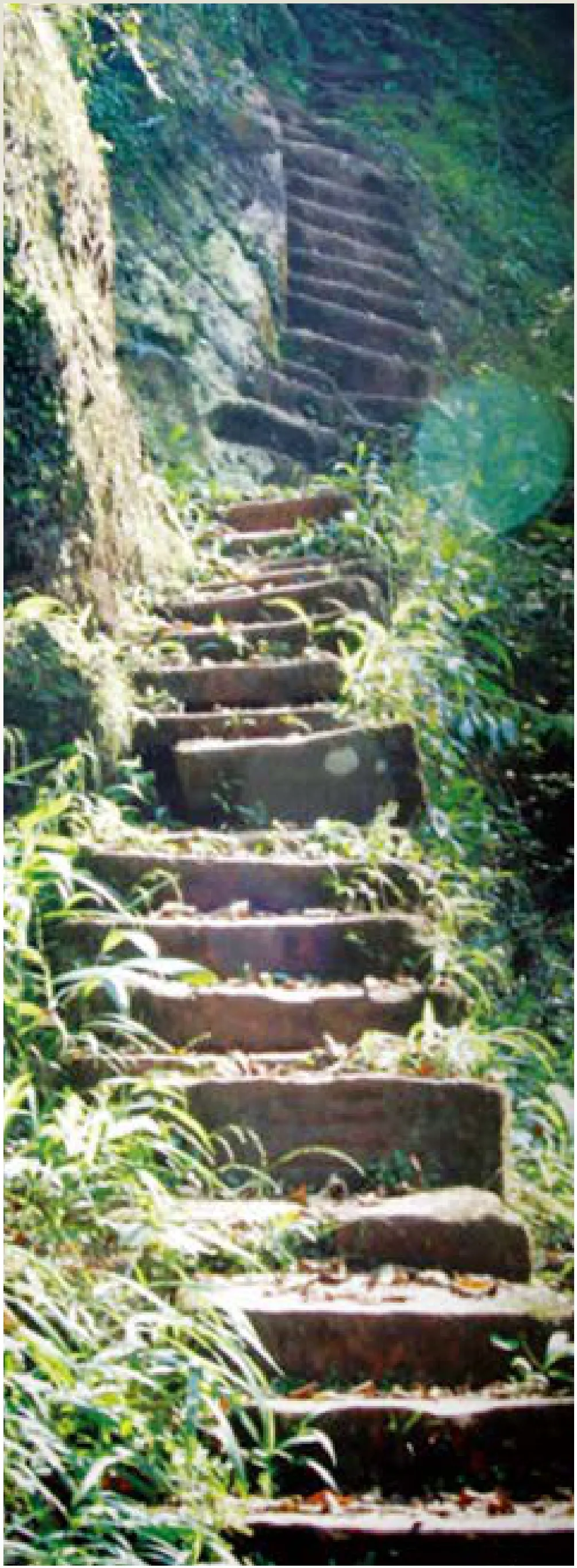古道“天梯” 百年沧桑
2015-07-03李静
□ 文/本刊记者 李静
古道“天梯” 百年沧桑
□ 文/本刊记者 李静

千百年来,知难而进的重庆人“走”出了很多古道。“蜀道之难,难于上青天”,李白的千古名句给予了巴渝古道最直观也是最贴切的形容。本期,我们将来到歌乐山,回顾这处旧时重庆通往成都的必经之地,再次聆听商贾行人来往不断的繁华之音,将您带回昔日风光繁华的三百梯古道。
隐藏于崇山峻岭间的“天梯”
歌乐山的美丽风光,早在百多年前,就闻名世界。1883年,闯进中国西部的首位洋人——英国商人立德乐来到重庆,看到清水溪沿途和歌乐山的风景很美,便在重庆写下了游记,详细介绍川东古道沿线的歌乐山、磁器口和清水溪一带的风光。立德乐的游记,后来也成为打开重庆通往世界大门的钥匙。
现在提到歌乐山的川东古道,很少有年轻人知道。100年前,从重庆到成都,只有川东古道可走。从重庆主城(渝中区)出发,经佛图关,沿山脊行走,到石桥铺分界。然后向右走,继续沿山脊行走,经大龙山(现平顶山)、大龙坎、小龙坎,穿过清水溪,到达龙隐镇(今磁器口),然后经过石板路,步入三百梯,最后到达歌乐山高店子,继续向成都方向行走。从磁器口到三百梯的石板路总长有五里路,现在三百梯保存完好的石板路只有500米。
三百梯有名,并非是它的里程长,路途崎岖陡峭,而是因为它是古代横贯全川东西,仅次于成渝官道东大路,名叫“小川东路”中,连接川渝翻越海拔600米歌乐山的石梯大道;是历史上川渝商旅行人往返于川渝间,比传邮驿道东大路官道要少走80多华里的一条便捷的交通要道。在沙坪坝区境内的路线是:从佛图关起点,经平顶山、小龙坎、杨公桥、黄泥堡至歌乐山脚步云桥登上“三百梯”,经同善桥、戴公祠、黄桷树(高店子)、冷水沟到虎溪出境。
三百梯是这条古道上勾通川渝通邑大道上的一道石板梯道。曾被古代诗人和抗战时期迁都重庆的国民政府主席林森称为“天梯”。林森到重庆后,寄情于山川名胜,定居于歌乐山云顶寺。他十分赞赏婉蜒于崇山峻岭云缠雾锁,乱云飞渡,凌空劈开一架连接川渝交通的“云梯”三百梯。遂挥毫题写了“云梯”两个大字,请石匠镌刻在官邸林园一号楼石侧的崖壁上,至今仍保存完好。在昔日交通闭塞的年代,奔波在小川东道的商旅行人和山上的民众,到了高店子下了“天梯”,就高兴地说:“快了,快到重庆城了。”则称三百梯为“天梯”。
文物古迹见证古道昔日繁华
三百梯建于哪个年代?由于它是小川东路的一段,据史料记载小川东路建于明代中叶(大致在明成化年间公元1465—1477 年),这与重庆林业家根据三百梯尽头老黄桷树的年轮测定树龄为400年,并评定为“重庆黄桷树王”的论断相一致。迄今三百梯已有400多年历史了。随着岁月的变迁,三百梯古道上的历史文物古迹,大都湮没无存了。经沿途探寻考察,值得庆幸的还发现一些具有文物价值的遗迹古迹,它们都见证了三百梯沧桑变换的风雨历史,耐人寻味。
在中段同善桥下面一段右边悬崖上,有两处青石砌就的石梯护栏。由于年代久远,风雨剥蚀,石质已严重风化,东倒西歪地斜卧在荒草之中。这正是古道年代悠久的历史见证。再看护栏上面的梯道,石级已残缺,长长一段是在裸露光洁的崖石上凿成的石阶,历经长年累月的人脚和马蹄铁掌地踩践,石阶已变得无角无棱、凹凸不平、平滑如砥的弧形。令人联想到上个世纪或更古老年代的踏踩磨损,踩踏出历史的古老和负载的沉重。
古老的市镇高店子老街和遗存清朝的石碑告示,在历经数百年的岁月沧桑后,至今仍保存完好。历史上,高店子不仅是重庆到成都的必经之地,往来商旅行人众多,街上店铺生意兴隆,而且还是一个驿站,过往客商都在此歇脚、打尖。它是三百梯古道尽头的古镇。清朝中叶属巴县直里一甲,民初是西里重镇高店乡政府的所在地。生意兴隆,热闹非凡的古镇高店子是三百梯繁盛兴旺的历史见证。
为重庆人所熟知,有“重庆黄桷树王”美称三百梯尽头的古黄桷,更是三百梯兴衰变迁的重要见证。它那树荫覆盖600多米,有六层楼高的树冠,有如沧桑岁月老人,在岁月风刀霜剑中,亲眼目睹三百梯的枯荣兴替,见证过多少翻腾的历史风云。现今虽已令人遗憾的衰老枯死,但依旧是三百梯最具有文物价值的古迹。
至于流传于民间的《高店子黄糕粑》的民间传说和“高店子黄糕——去不吃,回来也要吃”的“重庆言子”更是传遍四川五州十八县,已编入《重庆民间传说三集成》。常住山上的老人说,老黄桷树下彭幺嫂开的黄糕店名扬川渝,确有其人其事,她家就住在鸡公山下。古老的传说和脍炙人口的重庆言子,都从另一角度,生动地印证三百梯沉淀的历史时光。
在越过古道残留的石护栏,古道上横跨溪流上单孔的石拱桥是三百梯道上唯一的一座具有文物价值的古桥——同善桥。桥上和桥畔没有记载古桥历史的碑刻,而在洞内石壁上发现“建于清朝同治十二年”的石刻。同治十二年(公元1878年)至今已有123年的历史。历经一个多世纪的风雨岁月,古桥依然完好牢固的屹立在三百梯古道上。古桥古朴,造型美观。显然,同善桥是在三百梯和小川东路通行后建造的。据说,同善桥是清代同治年间,在被山洪冲毁的石板便桥基础上,由当地乐善好施的乡绅,共同集资重建造的,故名同善桥。
“无限风光在险峰”
经历了百年沧桑的三百梯,承载着历史的渲染,却也保留着其怡人的风光,仿佛经过时间的冲刷,没有一丝褪色,反而更加耀眼。自古以来,这里就是重庆人在金秋时节和重阳节,出城入山登高赏景,寻幽揽胜的好去处。多年来,沙区旅游局举办的登山健身的各种活动,登三百梯,领略古道风情,倍受游人的青睐。春天,细碎碎的阳光落下来,和家人一起来这里散散步,也是件很惬意的事。
当人们站立山脚步云桥畔向上仰望,三百梯古道在曲折的层岭密林中,若隐若现,宛如一条长龙在烟云弥漫中延伸。拾级而上边攀登边浏览歌乐山景风光,使你遐思联想岁月沧桑的古道上长年累月,轿子滑竿成群结队,马蹄在石板上叩响的繁忙景气。
诗云:“无限风光在险峰”。三百梯最佳的风光在中段。当你从左为峭壁右为深谷进入石栏杆梯道,眼前忽然开朗。坡度变得平缓,古道两边层岭密树、林壑幽美,一条从高山山水冲刷形成的溪沟,流水淙淙。沟涧岸边茂林修竹,一笼笼慈竹竹梢如凤尾,厚而密的竹枝直垂地面,新竹如箭,直指苍天。林间鸟语蝉鸣,密林深处,几家农舍院落,花果挂满枝头。常年居住于此的一名八旬老翁告诉我,他是1938年迁来三百梯,当年古道热闹得很,就是因为这里风景好,他几代人都长住这儿。
行走在林间,踏上同善桥,桥上为苍松翠柏所笼罩,行人在树荫华盖下通过。山风吹来,风动谷应,青峰秀岭,对于久住燥音、大气污染中,在市井人流中穿梭,在汽车喇叭中入眠的城里人来说,置身于三百梯古道胜景中,回归大自然,享受森林浴,洗尽凡嚣,定会产生超凡脱俗、心驰神摇美的境界中。而这一切,只有攀登古道,身临其境,方能领略到。
Through the ages, Chongqing people who have been always advancing despite difficulties blazed many ancient roads. Li Bai’s famous poem “the road to Shu is hard, even harder than climbing the sky.” gives the most vivid and accurate depiction of the Ba-Yu ancient roads. In this issue, we will take you to Gele Mountain to revisit the road that travelers must pass through when travelling from Chongqing to Chengdu in the old times, reminisce about the incessant hustle and bustle of trade and business there, and recollect the Sanbaiti Stairway where prosperity once dwelt.
“Stairway to Heaven” Hiding among the Mountains
The picturesque Gele Mountain became world-known as early as more than a hundred years ago. In 1883, as the first foreigner who set foot on the land of Western China, British businessman Archibald John Little arrived at Chongqing. Seeing the beautiful scenery of Qingshuixi and Gele Mountain, he wrote down travel records to introduce the sceneries of Gele Mountain, Ciqikou and Qingshuixi along the Eastern Sichuan ancient road. His travel journals had later become a key for Chongqing to be known by the world.
Nowadays, the Eastern Sichuan ancient road on the Gele Mountain is barely known by young people. A hundred years ago, it is the only way from Chongqing to Chengdu. Starting from the core urban area (Yuzhong District), travelers went through Fotuguan Pass and walked along the mountain range until they reached Shiqiaopu. After turning right, they continued walking along the mountain range, and then went pass Dalong Mountain (now called Pingding Mountain), Dalongkan, Xiaolongkan, Qingshuixi to reach Longyin Town (today’s Ciqikou). There a slab-stone road took them to Sanbaiti Stairway which then led to Gaodianzi on the Gele Mountain, and from there they would go on walking towards Chengdu. The slab-stone road stretching from Ciqikou to Sanbaiti Stairway measured five Chinese miles, but now the well-preserved length stands only 500 meters. Sanbaiti Stairway acquired its fame not by its length nor the steepness and roughness, but by the fact that it was a stone stairway which found its way up the 600-meter-high Gele Mountain and connected Sichuan and Chongqing on the minor Eastern Sichuan road (second only to the official Eastern Road that cross Sichuan province from east to west in ancient times). And it’s a more convenient path for the businessmen and travelers going back and forth between Sichuan and Chongqing—more than 80 Chinese miles could be saved when compared with taking the official Eastern Road. The route within Shapingba District went like this: started from Fotuguan Pass, went through Pingding Mountain, Xiaolongkan, Yanggongqiao, Huangnibao to Buyun Bridge which connected Sanbaiti Stairway on the Gele Mountain, then passed Tongshan Bridge, Daigongci, Huangjueshu (Gaodianzi), Lengshuigou and exited from Huxi.
Past Prosperity Reflected by CuIturaI ReIics and Historic Sites
When was the Sanbaiti Stairway built? It was part of the Lesser Eastern Sichuan Road which according to historical record was built in the middle of the Ming Dynasty (around 1465-1477 A.D. during the Chenghua Reign). This coincides with the fact that the age of the old Ficus viren tree standing at the end of the Sanbaiti Stairway, appraised as the“King of Ficus viren in Chongqing”, has been measured by tree expert as 400 years old. Sanbaiti Stairway now has a history of more than 400 years. As time passes by, most of the cultural relics and historic sites along this way have disappeared. Fortunately, exploring along the road, you will still find some relics and sites which are loaded with cultural value. They observed the changing history of Sanbaiti Stairway and thus become quite thought-provoking.
On the right side of the cliff below the middle section of Tongshan Bridge, two sections of stone-made stairway railings can be found. Tempered by time and weathered by wind and rain, the stones have been eroded, lying on all sides in the weeds and telling the long-time history of this ancientpath. Take your eyes to the stairs whose treads has become incomplete, you will see a long segment of the stairs which was cut out of the bare and smooth cliff stone. After the longtime treading by footsteps and hoofs, the stair nosing have turned into non-angular and uneven curves, smooth as the whetstones. The sight may bring your thoughts back to last century or even older ages to feel the solemn history under those treading.
The old street in Gaodianzi and the official notice on the Qing Dynasty stone tablet are well-preserved, even after the vicissitudes of hundreds of years. In history, Gaodianzi was not only an inevitable route from Chongqing to Chengdu, but also a courier station, brewing prosperous businesses and attracting large numbers of businessmen and travelers who stopped here for refreshment. It was an old town at the end of the Sanbaiti Stairway. In the middle of Qing Dynasty, it belonged to the Yi Jia of Zhi Li in Ba County (in "Li-Jia" system, five households constitute a Li and ten a Jia), and was home to the Gaodian township government at the dawn of the Republic of China. Gaodianzi, with its thriving business and the hustle and bustle, serves as an eye witness of Sanbaiti Stairway’s prosperity in history. Well-known among the Chongqing people, the old Ficus virens famed as the “King of Ficus viren in Chongqing”standing at the end of the Sanbaiti Stairway knows more about the vicissitudes of this stairway. With the size of its shades measuring more than 600 meters and its crown standing as tall as a six-story building, the old tree, like an old man having gone through all the vicissitudes of life, observed the rise and fall of the stairway and the constant changes in its history. Regretfully it has become a dry wood, however, it still represents the most valuable heritage of the Sanbaiti Stairway.
The popular folk legend of “The Yellow Rice Cake of Gaodianzi” and the ancient “Chongqing Yanzi”(Chongqing local dialect)—“Yellow rice cake of Gaodianzi—if you didn’t tasted it on the way there, you will definitely have a bite on the way back” were wildly spread among the five prefectures and eighteen counties in Sichuan and has been edited into Collections of Chongqing Folklore. It was heard from the elderly living on the mountain that the yellow rice cake store under the old Ficus virens run by Mrs. Peng was famous in Sichuan and Chongqing. It turned out to be a true story and in fact Mrs. Peng lived at the foot of Jigong Mountain. The history of Sanbaiti Stairway is vividly reflected by the legend and the Yanzi from another perspective. Go passing the stone railing relics, you will find a single-arch stone bridge --Tongshan Bridge, the only ancient bridge loaded with cultural heritage value on the stairway. No inscriptions on the bridge nor stone tablet beside it can be found to tell the history, however, on the stone arch the inscription of “built in the 12th year of Tongzhi in Qing Dynasty” had been discovered. 123 years has elapsed since the 12th year of the Tongzhi reign (1878 A.D.). After a century’s time, the old bridge still arches over the ancient path of the Sanbaiti Stairway in good condition.
Infinite Views on the Steep Mountains
Sanbaiti Stairway, immersed in the 100 years history, still preserves its delightful scenery. Time has not worn away its ever glaring charm. Since ancient times, it has been an ideal place for mountain-climbing and sightseeing of the Chongqing people in autumn and the Double Ninth Festival. For many years, the fitness activity of climbing the Sanbaiti Stairway while appreciating the charm of the ancient path organized by the Tourism Bureau of Shapingba District has been highly popular among the people. In spring when bathed in the gentle sunshine, it is also a pleasant place for family outing.
As said in a poem, “From the steep mountains, infinite views could be appreciated” The most impressive scenery of Sanbaiti Stairway lies in its middle section. When you step on the stone-railing staircase with steep cliff on the left and deep valley on the right, the sight becomes open and clear. The slope turns less steep, the massive trees and wooded gully on both sides gives a tranquil beauty, and the gurgling brook formed by the mountain water flows slowly. On the brook banks stand the flourishing woods and tall bamboos whose twigs looks like the tail of a phoenix and the vertical stems resemble arrows shooting into the air. Twittering birds and chirping cicadas could be heard among the woods where several village houses are scattered, and in the yards flowers are blooming and fruits have turned mature on the trees. An old man in his 80s who lives here throughout the year told me that he moved to Sanbaiti in the year 1938 when the ancient path was in its boom, and owing to the beautiful scenery here, several generations of his family chose to reside.
Tongshan Bridge is covered by the umbrella of green pines and verdant cypresses providing shades for visitors who have come through the woods and are treading on the bridge floor. When mountain breeze blows, the valley will echo with its dancing woods. For the city people who commute in noises and air pollution and whose sleep is accompanied by the horns of the cars, to stand in the scenery of Sanbaiti Stairway, embrace the Mother Nature and breathe in the forest must be an extraordinary experience filled with refreshment and excitements. However, appreciation of all this could be gained only when you set your own feet on the ancient path.
Ancient “Stairway to Heaven”Through Vicissitudes
□ Written by Li J ing
